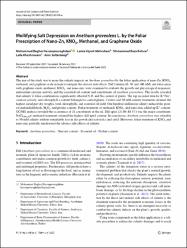| dc.contributor.author | Hassanpouraghdam, Mohammad Bagher | |
| dc.contributor.author | Mehrabani, Lamia Vojodi | |
| dc.contributor.author | Rahvar, Mohammad Reza | |
| dc.contributor.author | Khoshmaram, Leila | |
| dc.contributor.author | Soltanbeigi, Amir | |
| dc.date.accessioned | 2022-05-18T09:01:13Z | |
| dc.date.available | 2022-05-18T09:01:13Z | |
| dc.date.issued | 01.02.2022 | en_US |
| dc.identifier.citation | Hassanpouraghdam, M. B., Mehrabani, L. V., Rahvar, M. R., Khoshmaram, L., & Soltanbeigi, A. (2022). Mollifying Salt Depression on Anethum graveolens L. by the Foliar Prescription of Nano-Zn, KNO3, Methanol, and Graphene Oxide. Journal of Soil Science and Plant Nutrition, 1-13. | en_US |
| dc.identifier.issn | 0718-9516 | |
| dc.identifier.uri | https://doi.org/10.1007/s42729-022-00789-w | |
| dc.identifier.uri | https://hdl.handle.net/20.500.12933/1043 | |
| dc.description.abstract | The aim of the study was to assay the salinity impacts on Anethum graveolens by the foliar application of nano-Zn, KNO3, methanol, and graphene oxide in hope to mitigate the stressor side effects. NaCl salinity (0, 50, and 100 mM) and foliar spray with graphene oxide, methanol, KNO3, and nano-zinc were examined to evaluate the growth and physiological responses, antioxidant enzyme activity, and the essential oil content and constituents of Anethum graveolens. The results revealed that salinity × foliar combinations significantly affected N, P, and Na content of plants. The top recorded data for K+/Na+, catalase activity, and chlorophyll a content belonged to control plants. Control and 50-mM salinity treatments attained the highest aerial part dry weights, total chlorophylls, and essential oil yield. One hundred-millimolar salinity induced the greatest malondialdehyde, H2O2, and proline content. Foliar treatment of methanol, KNO3, and nano-zinc added up K+ content. GC/MS analysis revealed the occurrence of 21 constituents in the oil. Dill-apiol (24.06–88.5%) was the major constituent; NaCl100mM× methanol treatment attained the highest dill-apiol content. In conclusion, Anethum graveolens was tolerable to 50-mM salinity without remarkable loss in the growth characteristics and yield. Moreover, foliar treatment of KNO3 and nano-zinc partially ameliorated the adverse side effects of salinity. | en_US |
| dc.language.iso | eng | en_US |
| dc.publisher | Springer | en_US |
| dc.relation.isversionof | 10.1007/s42729-022-00789-w | en_US |
| dc.rights | info:eu-repo/semantics/embargoedAccess | en_US |
| dc.subject | Anethum graveolens | en_US |
| dc.subject | Nutrient content | en_US |
| dc.subject | Essential oil | en_US |
| dc.subject | Proline content | en_US |
| dc.title | Mollifying Salt Depression on Anethum graveolens L. by the Foliar Prescription of Nano-Zn, KNO3, Methanol, and Graphene Oxide | en_US |
| dc.type | article | en_US |
| dc.authorid | 0000-0002-8791-0482 | en_US |
| dc.department | AFSÜ, Eczacılık Fakültesi, Temel Eczacılık Bilimleri Bölümü | en_US |
| dc.contributor.institutionauthor | Soltanbeigi, Amir | |
| dc.identifier.startpage | 1 | en_US |
| dc.identifier.endpage | 13 | en_US |
| dc.relation.journal | Journal of Soil Science and Plant Nutrition | en_US |
| dc.relation.publicationcategory | Makale - Uluslararası Hakemli Dergi - Kurum Öğretim Elemanı | en_US |
















